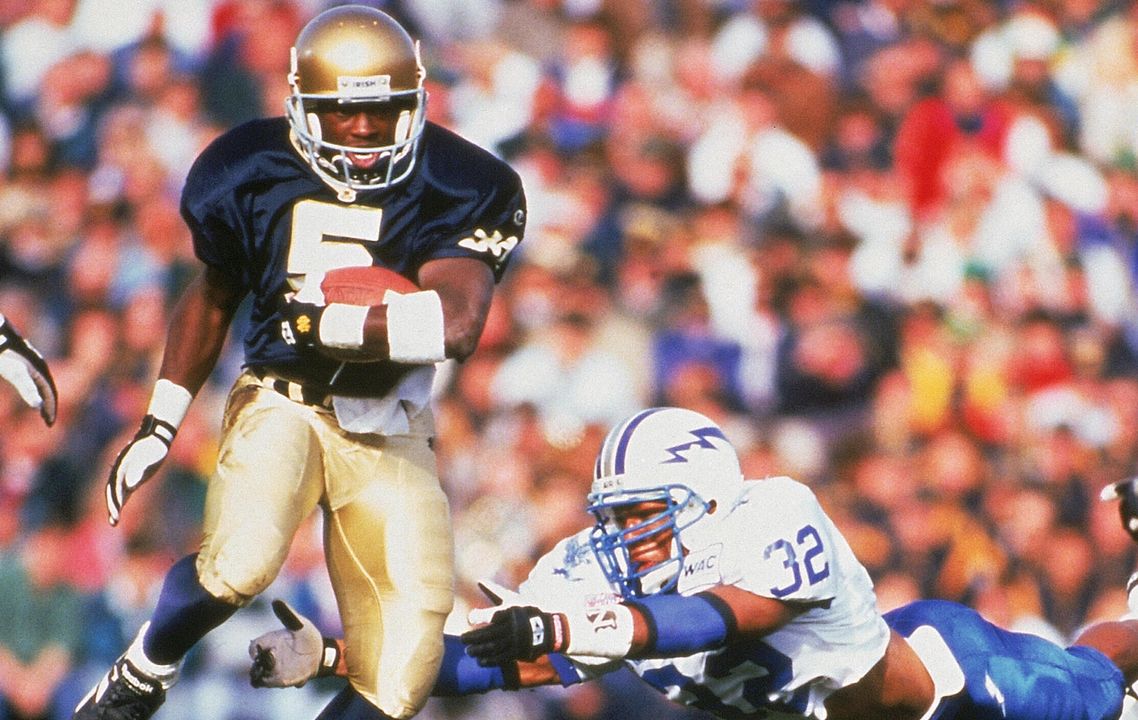October 19, 1996
Notre Dame Air Force Final Stats
By Brian Hiro, The Scholastic 1996 Football Review
October 19, 1996, was nothing short of the day a season died. On the road back to its rightful place atop the college football world, Notre Dame could perhaps be forgiven for stumbling against Ohio State, a team that has stockpiled so much talent over the past few years that the New York Jets might consider swapping rosters. Heck, with the way the Buckeyes were cruising through their schedule and up the polls, their domination of the Irish was beginning to look downright sensible.
But Air Force? Sure, those scrappy ser
vice academies sometimes give the Irish fits with their pint-sized but cerebral quarter backs and wishbone-them-to-death game plans. But Notre Dame’s superior athleticism eventually wears them down. It’s not like
the Falcons could actually win … in Notre Dame Stadium. Could they?
-scrimmage…. We tried to
isolate them, we tried to zone them, we tried to T block them. We tried ev erything.”
Air Force halfback Jamal Singleton is stopped cold
Air Force answered that question with a resounding thud – the sound of kicker Dallas Thompson booting a 27-yard field goal on the second series of overtime to silence an already quiet crowd and complete an improbable 20-17 victory over the Irish. With one swing of the leg, the Falcons had pulled off one of the season’s biggest upsets, ended Notre Dame’s slim national championship hopes and, some say, sealed Lou Holtz’s fate at the school.
How did it happen? Look no further than the trenches. Two weeks after racking up 397 rushing yards against a strong Washington team, the Irish could manage just a paltry 67 versus the Falcons, the fewest in Holtz’s 11 seasons. On the other side of the ball, the Air Force wishbone shredded the Irish defense for 304 yards on the ground, including 183 by senior quarterback Beau Morgan, who only seems like he has been around since the last time Air Force beat Notre Dame in 1985.
“I wish to congratulate Air Force for an excellent football game,” Holtz said after the game. “They beat us up front. They didn’t make mistakes and we made far too many mistakes…. We didn’t run the football well.
“Basically, they controlled the line of scrimmage. We tried to isolate them, we tried to zone them, we tried to T-block them. We tried everything.”
Despite Air Force’s inexplicable domination up front, the Irish grabbed a 17-10 lead early in the fourth quarter when Marc Edwards plunged one yard over right guard to cap an eight-play, 78-yard drive. But the Falcons showed no sign of quitting. They marched methodically to the Notre Dame 26-yard-line where, on a huge fourth-and-one play, Morgan pitched left to tailback Tobin Ruff, who sprinted untouched into the end zone.
In the extra session, the Irish had another chance to close out the pesky visitors, taking possession at the Air Force 25. But Ron Powlus fumbled on the first play when he was sacked by Falcon linebacker Joe Suhajda and teammate Alex Pupich recovered. Morgan would capitalize on the error. From the Irish 25, he used four short runs and a critical face mask penalty against Notre Dame to move the Falcons into chip-shot field goal range. Thompson did the rest, leaving the Irish faithful to ponder a New Year’s with out a bowl.
“I can’t say enough about our players,” said Air Force Head Coach Fisher DeBerry. “Both teams played hard. Our guys just never gave up. We emphasized to them that we were in here to win, not just to look good on national television. We really believed that anything was possible.”
The loss spoiled a gutsy effort from Powlus, who compensated for the dormant ground attack by completing 16 of24 passes for 268 yards in the face of an Air Force rush that sacked him three times and pressured him continuously. The yardage was a season high for Powlus and the third highest of his college career. He also set a school record by connecting on 11 consecutive passes dating back to the end of the Washington game. But he also fumbled twice with the game on the line, including the critical miscue on the first play of overtime.
An extra session seemed like a remote possibility when, midway through the first quarter, Allen Rossum fielded a punt at his own 43, sprinted up the middle and cut down the right sideline to give the Irish a 7-0 cushion. The touchdown came on Rossum’ s second career punt return and completed an impressive quartet of scores for the speedy cornerback that also includes a 99-yard kickoff return against Purdue five weeks earlier, a 76-yard interception return to seal last year’s win over Washington and a 98-yard blocked PAT return in the ’95 Texas game.
But the Falcons were not impressed by Rossum’s resume. On their next drive, they marched 66 yards in 10 plays and cut the deficit to four with a 21-yard Thompson field goal. It was a one-man effort as Morgan ran for 20 yards on a quarterback draw, threw to Marc Ranger for 10 on a rollout and then optioned left for 33 more before the drive stalled inside the 5-yard line.
Morgan’s heroics would continue on Air Force’s next offensive series. Using nine straight running plays, he led the Falcons 74 yards to the go-ahead touchdown, which he scored from five yards out by dragging Lyron Cobbins across the goal line. On the drive, Morgan had all but 13 of the team’s yards. Not bad for a guy who stands just 5′ 10″ and weighs 190 pounds.
“They read [our defense] … and the quarterback ducked it up inside,” Holtz said. “He is an excellent runner.”
Now trailing 10-7, Powlus and the Irish responded. From his own 30, the senior quarterback tossed in the flat to Emmett Mosley, who eluded two potential tacklers for a 28-yard gain. After a holding penalty set up second-and-25, Powlus found Malcolm Johnson for 13 and Shannon Stephens across the middle for 18 to sustain the drive. The Falcons finally held on their own 9 yard line and Notre Dame had to settle for Jim Sanson’s tying 27-yard boot. The turning point in the game might have been just before halftime with the Irish again on the march. From the Air Force 13, Powlus hit a sliding Raki Nelson for an apparent touchdown, but the pass was ruled incomplete. Replays showed that the freshman did indeed cradle the ball before it touched the ground. It would be foolish to argue that the missed call affected the game’s outcome – the Irish had plenty of chances to close out Air Force – but it certainly seemed to swing the momentum before the break.
“A touchdown before halftime would have been real good if we got it,” Holtz said. “I asked the official and he said the ball skipped. Raki Nelson told me he caught it and I thought he caught it.”
In the third quarter, the teams did little but exchange punts as the Irish defense finally began to solve the wishbone. And when Edwards gave the hosts a seven-point fourth quarter lead with his short touchdown, victory seemed to be in hand. But the Falcons roared back to score the game’s final 10 points and leave Notre Dame’s season in shambles.
“Air Force played their hearts out,” Holtz said. “I thought we would play better than we did. It is very disappointing.”
The visitors’ locker room expressed the opposite sentiment.
“This is as good as it gets,” Air Force linebacker Steve Fernandez said.”This feels about 500,000 times better than last week [their loss against Navy].”
For Holtz and the Irish, the feeling was painfully familiar. Another loss in the now not-so-intimidating Notre Dame Stadium. Another heart-wrenching defeat by a last second kick. Another early exit from the national championship race.
“We need to handle this with class,” Holtz said. “Is it easy to take? No. We have no excuses. We have to come out to play.”
Why bother, some thought. 1996 was supposed to be different. It was supposed to be a return to past glory. Instead, after the loss to Air Force, it just seemed over.








